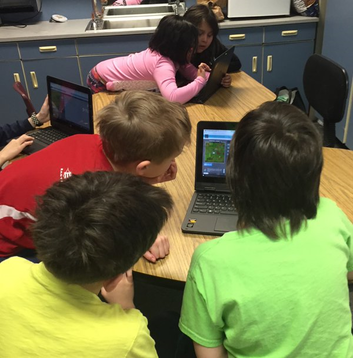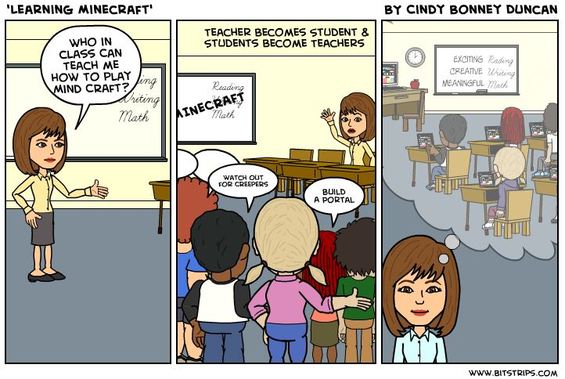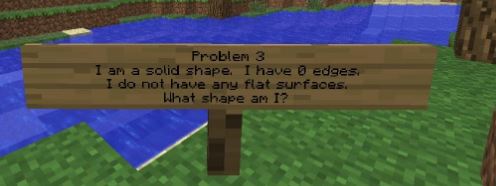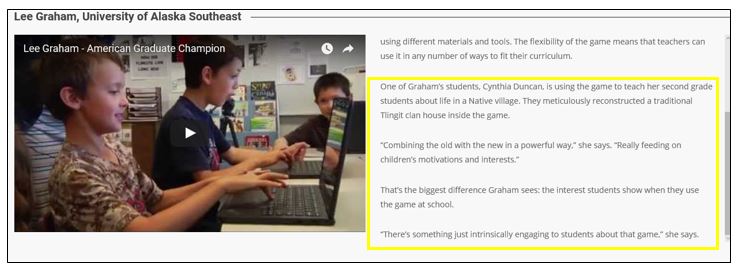"Why must we ask the 21st century to wait outside our classes? Is it just to protect the lecture? We know what a classroom designed around lectures, notes, and quizzes can do, and it is not impressive. . . . "
|
Growing up on a remote island in southeast Alaska felt isolating to say the least. As a child communicating with friends and family outside of Sitka involved letters and long distance phone calls. Research was limited to the books on the island. Watching a movie involved waiting for your turn at the video rental store. When you needed a phone number the local phone book was your go to resource. Shopping involved mail order catalogs. Traveling outside of Sitka require a travel agent. The list could go on. Life in the isolated town changed the day internet came to the island. Sitka became connected. We embrace 21 century advancements in our lives. Our classrooms should embrace these innovations as well.
|
Technology
NCTM 6, 7 & 8 / ACEI 2c

As an elementary teacher, I am always looking for ways to incorporate technology into my classrooms. Technology is shaping the way teachers teach and students learn. I use technology as a tool to enrich and support daily content learning. I use it to teach critical thinking, creative thinking, collaboration, and communication. I use it to teach informational, media and technology literacy. I use it to teach flexibility, balance, initiative, social skills, productivity, and leadership. I use it to teach my students to be responsible cybercitizens. I use it to prepare students for their future. Technology is not an option in education today. In 2014 I had the privilege of being interviewed by the White House about technology in education. One thing I stressed: we have to prepare students for jobs that haven’t even been created yet. We need to prepare them for the future.
Many years ago I read “Windows on the Future: Thinking about Tomorrow Today” by Ian Jukes and Ted McCain and it changed how I viewed education. Research has proven that children today are different neurologically from previous generations. They are different in how they: think, access, absorb, interpret process, view, interact, and communicate. We must not have schools that remain based on Industrial Age thinking. We live in a fundamentally different world. Change is already here. Technologically driven transformations haven taken place in the workplace. I remember walking into my classroom for the first time and feeling like I had gone back in time. The technology I had used so heavily in prior workplaces wasn’t being reflected in schools. We must make sure that our students are able to compete as well.
Many years ago I read “Windows on the Future: Thinking about Tomorrow Today” by Ian Jukes and Ted McCain and it changed how I viewed education. Research has proven that children today are different neurologically from previous generations. They are different in how they: think, access, absorb, interpret process, view, interact, and communicate. We must not have schools that remain based on Industrial Age thinking. We live in a fundamentally different world. Change is already here. Technologically driven transformations haven taken place in the workplace. I remember walking into my classroom for the first time and feeling like I had gone back in time. The technology I had used so heavily in prior workplaces wasn’t being reflected in schools. We must make sure that our students are able to compete as well.

One way technology is being used in my classroom is through game-based learning. This is evident in my making and game-based math lessons. The Gaming and Publishing Council stated that “Game-based learning has emerged as a promising area of innovation in addressing a vital weakness in American educational performance: the need to make academic content more engaging, adaptive, relevant and rigorous for America’s youth. Growing evidence demonstrates that digital games can be used to advance standards-based content mastery in literacy and math, develop a deep understanding of STEM concepts and build critical 21st century skills that are essential for preparing youth for success in a global and digital marketplace.” (Talbot 2015) Gaming has been around for Centuries. It makes sense to deliver curriculum through games. Students enjoy and value games why not connect it to learning and make learning irresistible.
We must educate those around us about any misconceptions they may have about 21st century learning. They need to understand that technology, making and gaming are tools that can be used to help students learn. Participating in specials about technology education is one of the ways I try to show technology can be use to facilitate learning. In my class I support a strong technology embedded education program based on national and state technology standards.
Work Cited
Jones, J. (2015, January 26). Let's Ban Bans in The Classroom - DML Central. Retrieved from http://dmlcentral.net/let-s-ban-bans-in-the-classroom/
McCain, T. D., & Jukes, I. (2001). Windows on the future: Education in the age of technology. Thousand Oaks, CA: Corwin Press.
Talbot, Mary. (2015). Quest to Learn Offers Glimpse of Game-Based Schooling. Quest to Learn Offers Glimpse of Game-Based Schooling. The Hechinger Report. http://www.gamesandlearning.org/2015/01/26/quest-to-learn-offers-glimpse-of-game-based-schooling
We must educate those around us about any misconceptions they may have about 21st century learning. They need to understand that technology, making and gaming are tools that can be used to help students learn. Participating in specials about technology education is one of the ways I try to show technology can be use to facilitate learning. In my class I support a strong technology embedded education program based on national and state technology standards.
Work Cited
Jones, J. (2015, January 26). Let's Ban Bans in The Classroom - DML Central. Retrieved from http://dmlcentral.net/let-s-ban-bans-in-the-classroom/
McCain, T. D., & Jukes, I. (2001). Windows on the future: Education in the age of technology. Thousand Oaks, CA: Corwin Press.
Talbot, Mary. (2015). Quest to Learn Offers Glimpse of Game-Based Schooling. Quest to Learn Offers Glimpse of Game-Based Schooling. The Hechinger Report. http://www.gamesandlearning.org/2015/01/26/quest-to-learn-offers-glimpse-of-game-based-schooling
Geometry Math LessonThis Geometry Treasure Hunt lesson I created students find shapes using clues in Minecraft. This lesson demonstrates my ability to use technology to enrich learning.
|
Technology InterviewThis video clip was filmed in the summer of 2015. This video interview demonstrates my knowledge and skillful use of technology to facilitate learning.
|
Proudly powered by Weebly

